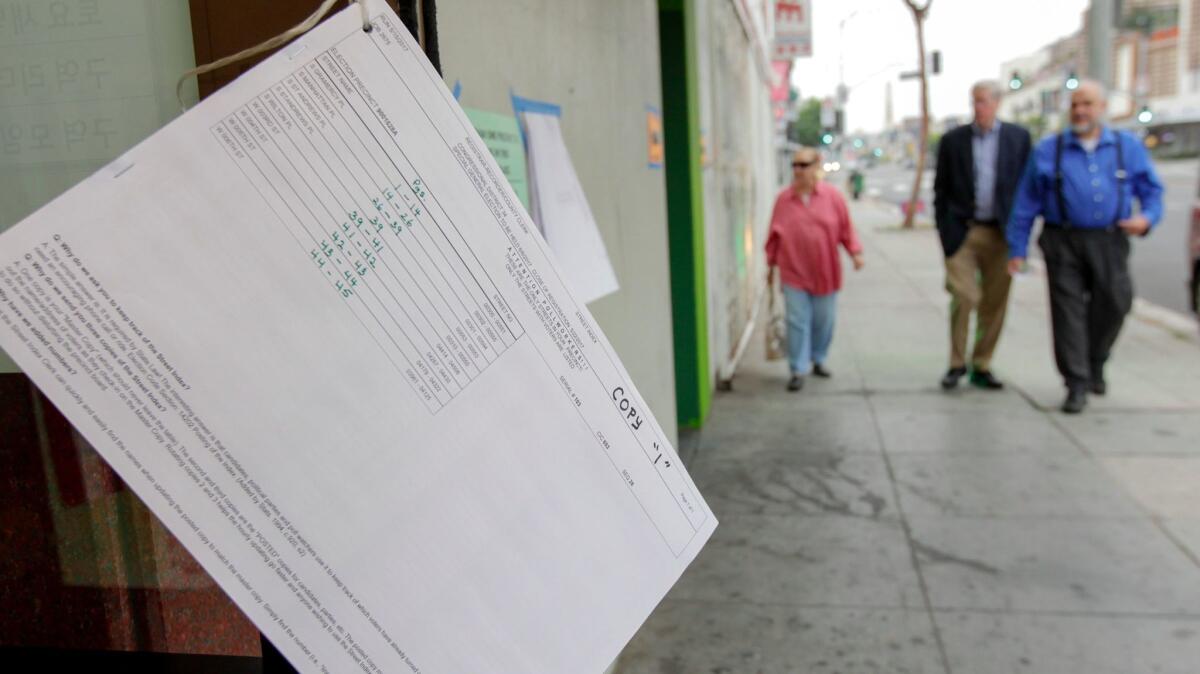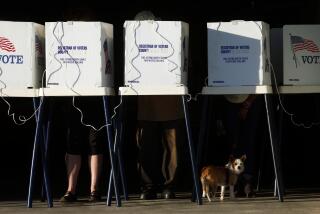Column: Political Road Map: Knowing who is (and isn’t) legally registered to vote in California

- Share via
Reporting from Sacramento — Perhaps the biggest takeaway from President Trump’s unproven allegations about the security of elections is that he’s managed to blur the difference between voting records and the act of voting.
Or put another way, it’s a distraction from resolving the challenges in keeping voter registration data accurate and up to date.
Trump awkwardly waded into the topic last fall when he insisted millions of fraudulent votes had been cast in California and two other states. No evidence of widespread chicanery existed then, nor has any been brought forward since. At times, it seemed the president was wrongly conflating fraud with a 2012 nonpartisan study that warned of problems with some states’ voter registration lists.
Fast forward to last week, when a conservative legal organization insisted that 11 California counties have more registered voters than voting-age citizens. The group refused to share its methodology, and partly based its conclusions on the counties’ lists of “inactive” voters — people who haven’t cast ballots in the past two statewide elections.
Even the best registration list lives in a state of flux. Voters die. They enter prison on a felony conviction and forfeit their right to vote. They move and don’t notify elections officials. “Things change every day, and our voter file is constantly fluid,” said Gail Pellerin, registrar of voters in Santa Cruz County. “It’s real people.”
Political Road Map: Here’s why California counties can ignore a half-dozen election laws »
Keeping California’s lists accurate became easier with the launch of a long-awaited statewide voter database last year. Now, changes are quickly seen in all 58 counties and data imported from state agencies — including the DMV and prisons — helps more easily flag problems.
Some believe California might also rethink its refusal to join states sharing voter information through a nonprofit called the Election Registration Information Center. Created five years ago, it’s helped 20 states and the District of Columbia catch more than 6.5 million voters who changed addresses, plus 194,000 voters who died. California opted not to join the center, citing questions about its privacy rules and the cost of paying membership dues.
But the state’s new database could make the multistate consortium a valuable tool. “We’re now in a much better place to entertain that,” Secretary of State Alex Padilla said last week.
Change might also be useful when it comes to paid voter registration drives. Tens of thousands of Californians are signed up by for-profit companies hired by political parties. Critics argue that the efforts often produce flawed or false registrations. After all, vendors get paid by the number of voter cards they turn in.
Consistency is an issue, too, when it comes to purging names off voter registration lists. County registrars have wide discretion, and some worry about striking too many names and denying people a legal right to vote. But should there be a single, statewide standard for these lists of “inactive” voters?
“It might help take the guesswork out of it,” said Kim Alexander, president of the nonpartisan California Voter Foundation. Of course, any new mandate would require the state to “pony up and pay the money,” she said — something that’s long been a problem with elections operations in California.
In short, California’s voter lists are undoubtedly better than they used to be. And that’s good, because they’re going to get tested in 2018. The state’s new automated voter registration process begins at DMV offices in April, and could sizably boost voter rolls. Next year will see the first statewide use, too, of the law allowing voter registration on election day. And it’s the first election in which some counties will opt to close polling places in favor of absentee ballots.
Knowing who’s eligible to vote is important. While many elections officials think Trump’s unfounded fraud accusations will erode the public’s faith in voting, the best antidote might be a fresh look at the lists of those signed up to cast ballots in the first place.
Follow @johnmyers on Twitter, sign up for our daily Essential Politics newsletter and listen to the weekly California Politics Podcast
ALSO:
Trump’s voter fraud panel again asks for California data — and again, the answer is no
The latest on California politics and government
More to Read
Get the L.A. Times Politics newsletter
Deeply reported insights into legislation, politics and policy from Sacramento, Washington and beyond. In your inbox three times per week.
You may occasionally receive promotional content from the Los Angeles Times.











